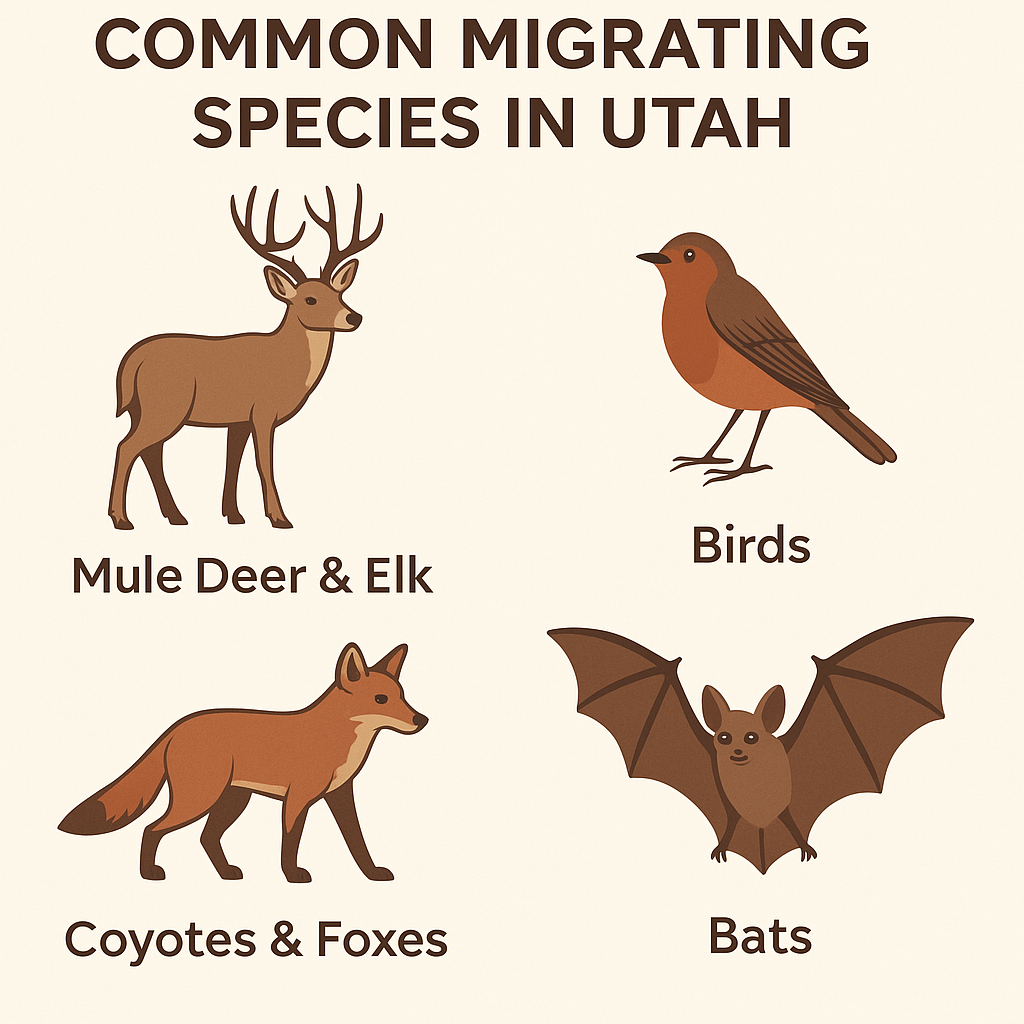Understanding Seasonal Migration Around Your Property
What Is Seasonal Migration?
Seasonal migration is the natural movement of animals from one habitat to another as the seasons change. Wildlife typically migrates to access better food sources, milder weather, or safe breeding grounds. This instinctive cycle happens on a massive scale across Utah—especially in rural, mountainous, or high-elevation areas.
If you own land in Duchesne, Fruitland, Argyle Canyon, or nearby remote regions, you may notice that wildlife presence changes dramatically throughout the year. In spring and summer, you might spot deer, elk, or birds regularly. In fall or winter, many of those animals may vanish completely—having migrated to lower elevations or warmer zones to survive the cold.
Understanding these migration patterns is key to living in harmony with the land—and using it responsibly.
Common Migrating Species in Utah
Utah is home to diverse wildlife that migrates across both short and long distances. Some move between valleys and mountains, while others follow continental migration routes through the state.
Here are a few of the most common seasonal migrators:
Mule Deer & Elk – These large mammals follow elevation changes, often wintering at lower altitudes and moving into the mountains during the summer.
Birds – Canadian geese, cranes, hawks, swallows, and many songbirds travel thousands of miles, stopping to rest and feed across Utah's open landscapes.
Coyotes & Foxes – These animals adapt their territories depending on food availability and environmental pressure.
Bats – Many bat species either migrate or hibernate during the colder months, making them less visible in winter.
Depending on your elevation and local terrain, your property might serve as a critical stopover point or seasonal home for some of these species.
Why It Matters for Landowners
Owning rural land means sharing space with the natural world. Recognizing when and how migration happens helps you care for your land responsibly and protect the wildlife that depends on it.
Here’s why migration awareness is important:
Seasonal Visibility
You may see herds of deer in spring and fall, then nothing all winter. This is completely normal. Understanding this pattern helps you plan for observation, photography, or hunting—without wondering if something’s wrong.
Hunting Regulations
In Utah, hunting seasons and licensing often align with migration cycles. Knowing when animals pass through your property can help you stay compliant and plan your activities within legal timeframes.
Fencing & Road Safety
Migrating animals—especially deer and elk—often cross highways, backroads, and private driveways. Being aware of seasonal movement can help you improve fencing or add signage to reduce risk to both animals and drivers.
Habitat Preservation
Your land might lie within an important migration corridor. Developing or fencing off too much of it could block ancient routes animals have used for generations. Leaving some areas undeveloped or minimally disturbed helps wildlife pass through safely.
Tips for Coexisting With Migratory Wildlife
Supporting migration doesn’t require becoming a wildlife expert. A few simple adjustments can help you live in balance with the land’s natural rhythms.
1. Avoid Building in Known Migration Corridors
Before placing permanent structures—like cabins, sheds, or fences—consult with your local Division of Wildlife Resources office. They can help identify if your land is part of a migratory route or seasonal habitat zone.
2. Keep Fencing Wildlife-Friendly
Traditional fencing can trap or injure wildlife. Use smooth-wire fences with a minimum of 16 inches of clearance at the bottom and 40 inches maximum height to allow deer, elk, and other animals to pass through or jump safely.
3. Don’t Feed Wildlife
Feeding animals—even with good intentions—can interrupt migration cycles, create dependency, and increase the chances of disease spread. Let natural food sources guide their movement instead.
4. Use Cameras to Monitor Patterns
Setting up trail cameras on your land allows you to see when animals are passing through, how often, and which species are active. This helps you better understand the migration rhythms of your property—and can be a fun way to stay connected to the land.
5. Respect Natural Distances
Avoid chasing, photographing up close, or disturbing animals during migration. Stress can be dangerous—especially during long journeys or in harsh weather conditions.
Final Thought
Seasonal migration is one of the most beautiful and essential parts of owning land in Utah. It connects your property to a larger ecosystem—one that has existed long before any road or fence.
By understanding how migration works and making small changes to support it, you help keep that ecosystem alive and healthy. Whether you’re using your land to build, camp, or simply enjoy nature, learning to coexist with Utah’s migratory wildlife brings a deeper sense of connection—and a lot more wonder.


